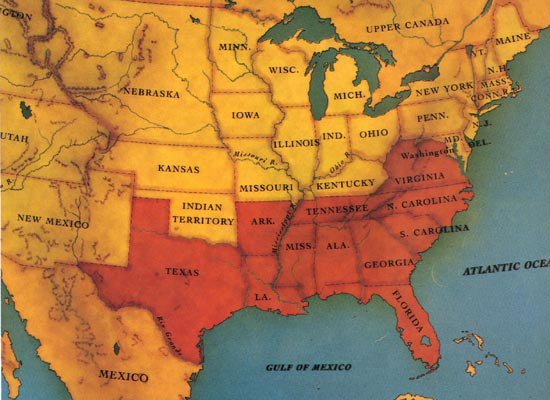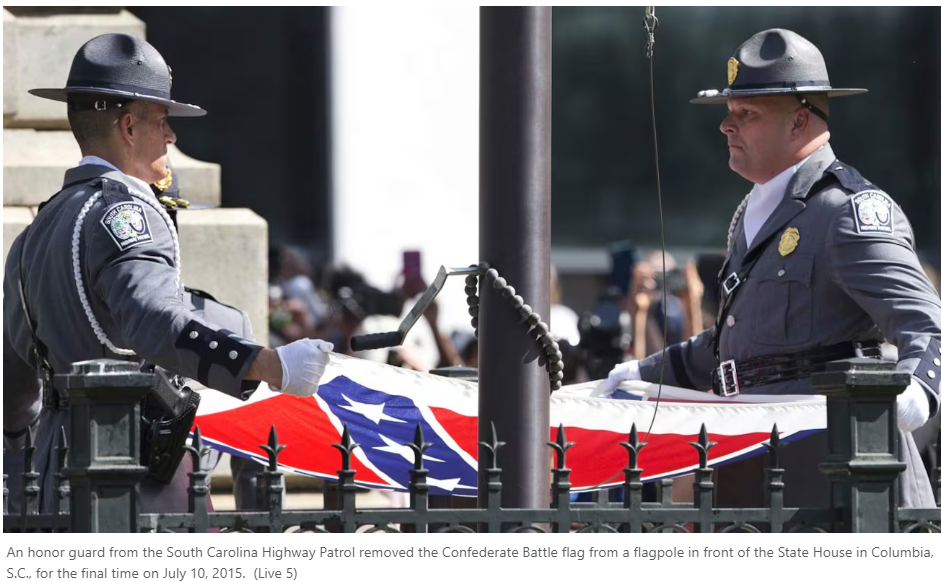Virginia: Confederate Letters Reveal Personal Side of War
Virginia: Women, Children in Civil War Explosion Remembered
RICHMOND, Va. — They were little-known casualties of the Civil War: women and girls toiling over cartridges and primers for Confederate cannons when an explosion rocked their factory 150 years ago, leaving more than 40 dead and others horrifically burned.
The victims of the March 13, 1863, explosion of the Confederate Ordnance Laboratory were remembered Wednesday at a ceremony along the James River near what once was a bustling munitions plant for the South. Today it is a popular destination for Civil War buffs, concert-goers and downtown workers on their lunch break.
The ceremony dedicating a state historic marker in memory of the victims, many of them Irish immigrants, was attended by National Park Service historians, state officials and a representative from the Irish American Society of Richmond. They gathered across from Brown’s Island, where the ordnance complex was located to keep it a safe distance from the residents of the capital of the Confederacy.
The victims were young, some pre-teen, others in their 20s.
“They were like 11, 12, 13, 15. They wanted them to work at Brown’s Island because they had small fingers and they could do the work and they were immigrants and having a job in America as opposed to subsistence living in Ireland seemed to be a good deal,” said Dan Begley of the Irish American Society.
They were among 2,200 Irish-born residents of the city of 37,000 in 1860.
“This was deemed the sort of labor that young women could do,” said Robert E.L. Crick, a historian with the National Park Service. “It certainly wasn’t safe but it wasn’t strenuous.”
The lab was among the foundries along this downtown stretch of the James River that produced munitions for the war. Tredegar Iron Works, now home to the American Civil War Center and Park Service exhibits on the war, produced about half the cannon barrels for the South, and the Confederate States Armory up the hill from Tredegar built small arms.
The lab explosion occurred in the middle of the river, on Brown’s Island, which is often crowded most summer weekends with family picnics, hikers and bikers.
At approximately the same hour as Wednesday’s ceremony — 150 years ago — a worker named Mary Ryan accidently ignited a friction primer that sparked the deadly explosion.
An account in the Richmond Examiner reported that “a dull, prolonged roar” echoed from Brown’s Island, attracting “frantic mothers and kindred of the employees of in the laboratory” to the banks of the James. The building was “blown into a complete wreck, the roof lifted off, and the walls dashed out…” the newspaper reported.
Those responding to the explosion were met with the horror of what had just happened: the dead being carried from the smoldering remains and the near-dead “suffering the most horrible agonies, blind from burns, with hair burned from their heads, and the clothing hanging in burning shreds…”
Two men and a boy were among the dead.
The tragedy was followed by an outpouring of giving from the city, whose economy was in a shambles, and from Confederate Gen. Robert E. Lee’s troops, who were staged outside Fredericksburg.
The dedication of the Department of Historic Resources marker was accompanied by the playing of bagpipes and with satisfaction from Begley, who said it shines a light on another side of the Civil War, its battles and generals.
“There’s always been immigrants and there’s always been immigrant stories here, even here in Richmond,” he said. “I’m very happy that there’s some kind of story pertaining to personal lives ….”
–Steve Szkotak, Associated Press
###
Tennessee: Volunteers Sought for Battlefield Restoration
MEMPHIS, Tenn. — The Civil War Trust is looking for volunteers to clean and restore 10 battlefields in Tennessee.
Volunteers can contact the trust to participate in the 17th annual Park Day, scheduled for April 6. They will be asked to rake leaves, haul![]() trash, paint signs and plant trees.
trash, paint signs and plant trees.
The nationwide event includes 100 historic sites in 24 states.
The Tennessee sites are Britton Lane Battlefield in Medon, Chickamauga and Chattanooga National Military Park in Chattanooga, Fort Donelson National Battlefield in Dover, Fort Granger in Franklin, Fort Pillow State Historic Park in Henning, The Mabry-Hazen House in Knoxville, Parker’s Crossroads Battlefield Park, Shy’s Hill-Battle of Nashville, Shiloh National Military Park and Stones River National Battlefield in Murfreesboro.
###
Tennessee: Sparks Inspired by Fiery Civil War Story
Almost exactly 150 years ago, a Confederate hero was just beginning a path that would lead to his torturous death, and now a local politician has decided to honor his legacy.
The waning winter weeks of early 1863 had seen Confederate Gen. Braxton Bragg’s Army of Tennessee enjoying the longest period of inaction afforded any considerable body of confederates during the entire course of the Civil War.
Bragg had first retreated to Tullahoma after fighting at Murfreesboro’s Battle of Stones River, and the army continued to bloodlessly cede ground throughout the late winter and early spring until securely fortified along the ridges of Chattanooga.
Meanwhile, DeWitt Smith Jobe, a native of Mechanicsville in northern Rutherford County, joined an elite group of Confederate spies known as the Coleman Scouts and commenced, along with Sam Davis of Smyrna, to collect and transmit information to the rebels from behind Union lines.
Both were captured, but Jobe’s story is less well-known and considerably more gruesome, though an historical marker stands near his boyhood home and burial site.
The community of Mechanicsville has since been swallowed by the growth along Smyrna’s Sam Ridley Parkway, but the site remains largely intact along a ridge just a short walk from Rocky Fork Road.
As a sesquicentennial reminder of Jobe’s life, state Rep. Mike Sparks (R-Smyrna) has organized an historical presentation honoring Jobe from 9 a.m. to 11 a.m. Saturday, March 9, at the Giles Creek Baptist Church. Refreshments will be served.
Guest speakers include former Smyrna High School History teacher William McPeak, Rutherford County historian Gregory Tucker, Jobe family descendant John Moore, and James Patterson, adjutant of the Sons of Confederate Veterans.
The speakers will discuss Jobe’s life, like how, in August 1864, Jobe and fellow scout Tom Joplin were far behind Union lines and reconnoitering in southwestern Rutherford and northeastern Williamson counties.
On Aug. 29, 1864, Jobe was hiding in a cornfield after eating breakfast at the home of a family between Triune and Nolensville. He had an important message hidden on his person. With Yankee patrols in the area, the Confederate was hiding during the day and traveling at night.
Unfortunately, he was spotted by a patrol of 15 men from the 115th Ohio Regiment of the Union Army of the Cumberland.
Seeing that he was about to be captured, Jobe tore up the note and began to chew and swallow it.
Angered by the near miss, the Union patrol first threatened Jobe and then began to torture him in an effort to get the scout to divulge the content of the dispatch.
The Ohio troops first hanged Jobe from a bridle rein and then pistol-whipped him, knocking out some of his teeth.
“Bound and disarmed, helpless and bleeding, Jobe revealed nothing. They were dealing with a man in gray who held the welfare of the Confederacy above his life,” Ed Huddleston wrote in “The Civil War in Middle Tennessee.”
“The torture went on. The Yanks were whooping now, yelling so loudly that they could be heard at a distant farmhouse. They put out Jobe’s eyes. Perhaps then it was that Jobe heaped epithets upon them. How much courage did it take to do what they did then? They cut out Jobe’s tongue,” Huddleston wrote.
The Union patrol finished off Jobe by dragging him to death behind his own galloping horse.
The event is not mentioned in official records of the Union and Confederate armies, but was preserved in Jobe family oral history, as well as in letters and books like Bromfield Ridley’s “Battles and Sketches of the Army of Tennessee.”
The news of his torture reached his cousin Dee Smith while serving with the 45th Tennessee.
Smith immediately left his regiment to begin personally exacting revenge on any Union officer he found, which he did with a butcher’s knife.
Nearly 50 Yankee soldiers fell victim to Smith’s blade, 14 as they slept in their tents near Tullahoma.
“Of all the heroic stories of the Civil War, Dewitt Smith Jobe’s story is probably one of the most amazing. In his short life, he had such an impact on his family and friends right here in Rutherford County,” Sparks said.
Sparks also noted that although he was raised and attended public schools in Smyrna, he did not learn of Jobe until he was searching for information on the Coleman Scouts and found a Murfreesboro Post article on the subject.
He wants more school children to learn about such local history, and hopes that Jobe’s story will not disappear with time.
“Whether it is politically correct or not to tell the stories of these local confederate soldiers, we must tell them because they are an integral part of our community’s history,” Sparks said. “We must preserve our history for future generations.”
— JONATHON FAGAN, Murfreesboro Post
###





Trackbacks/Pingbacks